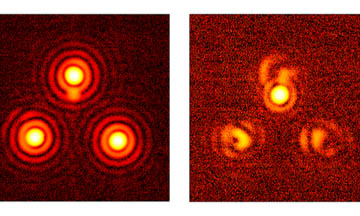
Laboratory demonstration of an optical vortex coronagraph system imaging a triple star system with a planet. The coronagraph is switched off in the left frame and on in the right frame. [Image: University of Bordeaux]
Astronomers have modified coronagraphs to detect extrasolar planets around distant single stars, but multiple-star systems present additional challenges. Scientists at a French university have proposed a new vortex coronagraph that uses a liquid-crystal thin film to mask multiple stars in a frame, making it easier to detect complex planetary systems (Phys. Rev. Lett., doi:10.1103/PhysRevLett.118.203902).
Liquid-crystal light valve
A coronagraph blocks the light from a bright object in an imaging frame, allowing scientists to study faint objects that otherwise would be invisible. (From the vantage point of Earth, its moon acts as a naturally occurring—though fleeting—coronagraph during a total solar eclipse.) A vortex coronagraph imparts an azimuthal or spiral phase shift to the light passing through it. Such instruments are already in use at the Hale Telescope and other observatories, but they are suited to solitary stars. By some estimates, roughly a third of the star systems in our galaxy consist of two or more gravitationally bound stars—and some of those systems may contain planets as well.
Etienne Brasselet and two colleagues at the University of Bordeaux, France, built a prototype vortex coronagraph incorporating a “liquid-crystal light valve,” made of liquid-crystal topological defects that are electrically tunable (Opt. Lett., doi:10.1364/OL.41.005234).
“The kind of liquid-crystal topological defects we are using spontaneously appear in a random manner in the plane of the sample under uniform electric field external stimuli,” Brasselet writes. “Of course, this is unacceptable when looking at multiple stars whose angular distance is fixed and differ from one extrasolar system to another.” One of the two substrates of the thin liquid-crystal layer in the valve is photoconductive, permitting the researchers to write, erase and rewrite the valve into multiple vortex phase masks to match the orientation of individual stars in each multiple-star system.
Testing star power
To test the system, the scientists set up three circularly polarized-laser light sources and a faint off-axis source to simulate a nearby planet. The putative “planet,” barely visible when the coronagraph was switched off, appeared bright when the device was powered up.
Later this year, Brasselet and his team plan to test a single-star version of the vortex coronagraph at the Paris Observatory. Building a multiple-star vortex coronagraph for one of the next-generation giant telescopes (such as those seen in OPN’s May infographic) will require negotiations with the astronomical organizations running the observatories. The Bordeaux group has already designed a second-generation multiple-star vortex coronagraph and plans to publish that work in the near future.
